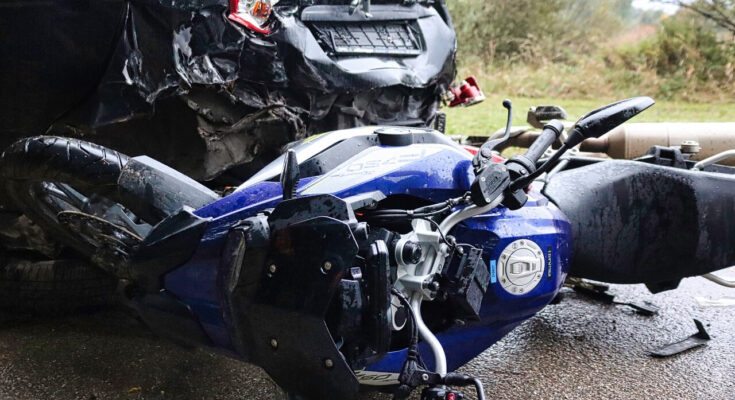Motorcycle riding offers a thrilling experience on the open road, but it also comes with inherent risks. Unfortunately, motorcycle crashes can result in a variety of injuries, some of which can be severe and life-altering. These incidents not only affect riders but also have broader societal and healthcare implications.
Here are six common injuries caused by motorcycle accidents and the physical, emotional, and financial toll they can cause.
1. Head Injuries
Motorcycle crashes often lead to head injuries, making helmets critical for riders. The most severe head injury is traumatic brain injury (TBI), which can range from mild concussions to severe, life-threatening brain damage. Even with helmets, riders are vulnerable, and the absence of proper head protection significantly increases the risk of TBI.
Symptoms can vary widely, from dizziness and memory loss to impaired motor function or cognitive deficits. Preventing head injuries in motorcycle accidents primarily involves wearing a certified helmet and adhering to traffic laws.
Suggestion: Jetson Bolt Pro Folding Electric Bike Review by Experts in 2023
In addition to TBI, facial injuries are common in motorcycle crashes. Riders who don’t wear a full-face helmet are particularly susceptible to facial trauma. These injuries can include fractures, lacerations, and damage to the eyes, nose, or jaw. The consequences of facial injuries can be not only physically painful but also emotionally distressing. Protective gear, such as full-face helmets and face shields, can mitigate the risk of facial injuries in motorcycle accidents.
2. Road Rash
Do motorcycles stop faster than cars? Motorcycles do have the ability to stop faster than cars, but attempting to stop quickly can cause serious accidents because of a loss of control, leading to the biker being thrown from the bike and suffering road rash and other injuries. When riders slide along the road surface during a collision, the friction can strip away layers of skin, causing severe abrasions. Road rash injuries vary in severity, with some requiring extensive medical treatment and skin grafts.
Infections are also a concern with road rash injuries, as open wounds can become contaminated. Riders can reduce the risk of road rash by wearing protective clothing such as leather or armored gear, which can provide a crucial barrier between the skin and the road.
Road rash injuries can lead to long-term scarring and may require ongoing medical care. Proper wound care, including cleaning, dressing changes, and infection prevention, is crucial to support the healing process and minimize complications. Additionally, road rash injuries can be painful and affect a rider’s mobility, making rehabilitation and physical therapy essential for recovery.
3. Broken Bones
Motorcycle crashes often result in broken bones due to the impact forces and the rider’s exposure to the external environment. Common fractures include broken legs, arms, wrists, and collarbones. These injuries can be painful and require immobilization, surgery, or both for proper healing.
Also Check: 7 Best 3-Wheel Electric Bike – Top Tricycle You Can Buy In 2023
Riders can reduce the risk of broken bones by wearing protective gear, including reinforced jackets, pants, and gloves designed to absorb and distribute impact forces. Broken bone injuries can lead to complications such as nerve damage, infection, or improper healing.
Timely and appropriate medical care, including setting and casting fractures, is essential to ensure the best possible outcome. Physical therapy may also be necessary to regain strength and mobility after the bone has healed. Riders should follow their healthcare provider’s recommendations and attend follow-up appointments to monitor their recovery progress.
4. Spinal Injuries
Spinal injuries, including spinal cord injuries, are among the most severe consequences of motorcycle accidents. These injuries can result in partial or complete paralysis and have a profound impact on a rider’s quality of life. The spine is highly vulnerable in motorcycle crashes, especially in high-impact collisions or when riders are ejected from their motorcycles. Preventing spinal injuries requires wearing proper protective gear, including spine protectors and back armor, and adhering to safe riding practices to minimize the risk of accidents.
Spinal injuries often entail extensive rehabilitation and medical interventions. Riders with spinal cord injuries may require assistive devices such as wheelchairs, braces, or mobility aids to regain some independence. Physical therapy plays a crucial role in maximizing function and mobility after a spinal injury. Riders and their families should be prepared for the emotional and psychological challenges that often accompany spinal cord injuries, seeking counseling or support when needed.
5. Internal Injuries
Internal injuries may not always manifest immediate symptoms. These injuries can include damage to internal organs, bleeding, or injuries to the chest or abdomen. The force of impact in a motorcycle crash can cause significant trauma to the body’s internal structures. Some internal injuries may require surgical intervention and become life-threatening if left undiagnosed.
Suggestion: 2024 Chevy Impala Review, Price & Released Date
Riders should seek immediate medical attention after a crash, even if they don’t exhibit external injuries, to ensure that potential internal injuries are promptly identified and treated. The recovery process for internal injuries can be lengthy, and riders should follow their healthcare provider’s recommendations and attend follow-up appointments to ensure their well-being.
6. Limb Injuries
Motorcycle crashes can result in a range of limb injuries, including fractures, dislocations, and severe soft tissue injuries. Limb injuries can significantly impact a rider’s ability to function, and recovery may involve surgeries, physical therapy, and extended rehabilitation. Proper protective gear, including armored jackets, gloves, and riding pants, can help reduce the risk of limb injuries by providing a protective barrier and absorbing some of the impact forces.
Limb injuries can lead to long-term disability or impairment, affecting a rider’s daily life and ability to work or engage in recreational activities. Riders should be prepared for the physical and emotional challenges that come with limb injuries and seek support or counseling when needed. Rehabilitation and physical therapy are essential components of recovery, helping riders regain strength, mobility, and independence.
Takeaways
The impact of motorcycle crashes extends far beyond the immediate collision. The injuries resulting from these accidents have long-lasting consequences that affect individuals, families, and healthcare systems. By acknowledging the risks, promoting safety measures, and advocating for responsible road behavior, people can reduce the prevalence of these injuries.



















